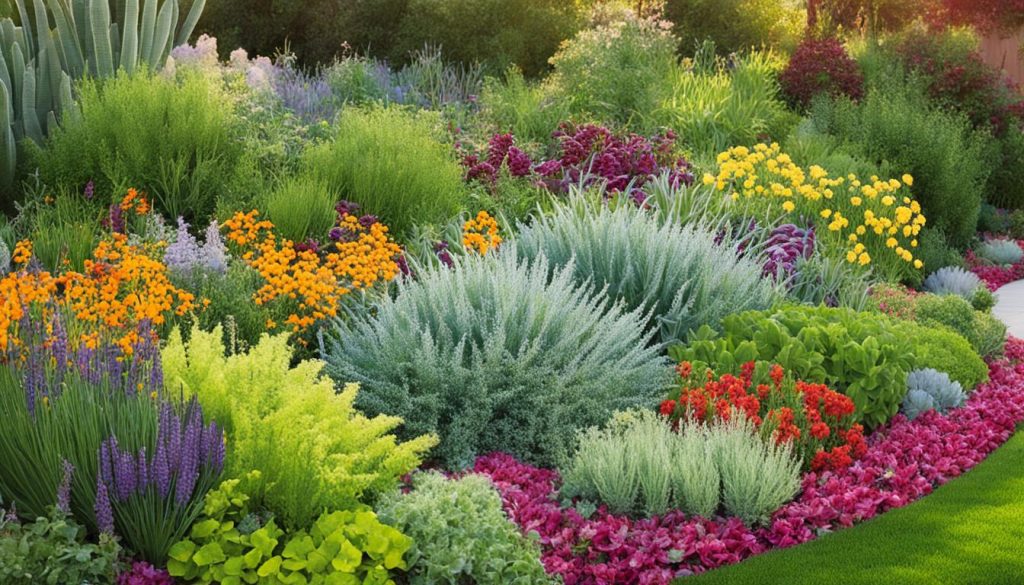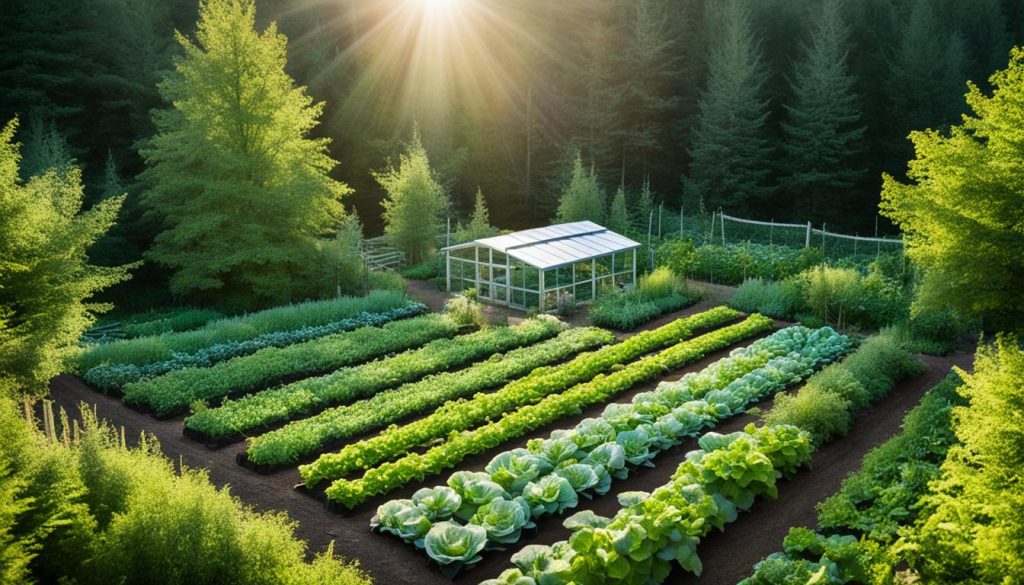Gardening without electricity is becoming more popular off the grid. People off the grid seek ways to produce food sustainably and without traditional power. By knowing natural systems, planning carefully, and using specific techniques, they achieve this.
Several things are crucial when starting an off-grid garden. You need to look at sunlight, soil quality, natural vegetation, and water. It’s key to check the soil’s nutrients and find a steady water source. You must decide if you’ll carry water or use a pump.
Using permaculture design can make your garden a lot easier to maintain. Planting companion plants and using natural pest control help a lot. It’s important to boost soil health with compost and organic fertilizers. This makes your garden more productive. Knowing your local growing season helps decide when to harvest.
Key Takeaways:
- Off-grid gardening is getting more popular for sustainable food.
- Good planning and knowledge of nature are vital for off-grid success.
- Choosing the right place, with good sun, soil, and water, is key for an off-grid garden.
- Using permaculture strategies can make your garden low-maintenance and self-sustaining.
- Planting certain flowers, attracting good insects, and natural pest control are big in off-grid gardening.
Choosing the Right Tools and Materials
To succeed in off-grid gardening, having the right tools and materials is essential. Proper equipment helps make gardening easier and supports sustainable food practices. Here are key items for off-grid gardeners:
Gardening Tools
- Buckets: Great for moving water, mulch, or fresh crops around.
- Watering Cans: They allow for careful watering, cutting down water waste.
- Trellises: Help plants grow up instead of out, using less space.
- Shovels: They’re key for digging and preparing the ground for planting.
- Hoes: Important for keeping weeds at bay and aerating the soil.
- Wheelbarrows: Make it easy to move heavy things like soil and compost.
The tools you need will vary based on your situation and what’s around. If you can rely on renewable energy, such as solar or wind power, you might use newer, electric tools. This makes gardening tasks simpler and faster.
DIY Garden Projects
Doing DIY garden projects boosts local growth and is good for the planet. It means you use fewer outside resources. This is a chance to be creative. Here are some cool DIYs:
- Building Trellises: Make trellises from bamboo, old wood, or PVC. They help plants grow up and save space.
- Rainwater Harvesting Systems: Set up barrels or tanks to catch and store rainwater. Then, use this water to nourish your garden. It’s eco-friendly and saves on water use.
Watering Techniques
Knowing how to water properly in off-grid gardening is key. You need to keep plants moist while using water carefully. Here’s how to water the right way:
- Rain Barrels: With rainwater, you can water your garden for free. It’s good for your budget and the earth.
- Natural Water Sources: Use local rivers, creeks, or ponds for watering if you can.
- Hand-hauling Water: When you don’t have a pump, carrying water by hand works for small gardens.
Always check on your plants’ water needs. This means finding a balance to keep them healthy without overwatering. Watch the soil moisture and adjust how often you water.
In the end, having the right tools and materials is vital for off-grid gardening. With essential items, DIY projects, and good watering practices, you can grow a lush garden and support sustainable food production.
Selecting the Right Plants for Off-Grid Gardening
Choosing the right plants is key for a great off-grid garden. Think about plants that need minimal water and light. Check what kind of soil you have as well.
Find plants that grow well in natural light and don’t need a lot of water. This way, you can save water. Look for plants that handle dry weather well.
Know what kind of soil you have. Some plants like sandy, loamy, or clay soil better. Pick plants that fit the soil to help them grow.
Planting Companions for Improved Health and Natural Pest Control
Companion planting can make your garden healthier. It can keep pests away and make your food taste better. For example, marigolds keep aphids and nematodes at bay. The strong smell of marigolds works as a natural bug repellent. This can reduce your need for chemical sprays.
Planting onions next to carrots can stop carrot flies. This lets both plants do well together.
Companion planting creates a more balanced and varied ecosystem. This way, plants support each other and grow stronger.
Do your homework on which plants work well together. This will make your garden a harmonious place where plants help each other grow.
Using Natural Pest Control Methods and Homemade Fertilizers
It’s wise to use natural ways to keep bugs off your plants. By avoiding chemicals, you keep your garden and the environment healthier.
Planting flowers like lavender and chamomile can naturally repel insects. Making your own bug sprays from things like neem oil or garlic is also effective. It’s a way to keep pests away without using chemicals.
Making your own fertilizers by composting can feed your plants well. It’s good for the earth, too. This homemade compost makes your soil rich, helping your plants grow strong and your garden become more productive.
By using these natural tips for pest control and feeding your plants, your off-grid garden can be a success. It’s a way to grow food sustainably.
| Water-efficient Plants | Description |
|---|---|
| Succulents | Succulents are known for their ability to store water in their leaves, stems, and roots, making them highly drought-tolerant. They come in various shapes, sizes, and colors, adding aesthetic appeal to your off-grid garden. |
| Lavender | Lavender is a beautiful and fragrant herb that thrives in well-draining soil. Its grayish-green leaves and vibrant purple flowers attract beneficial insects while repelling pests like mosquitoes and fleas. Lavender also requires minimal watering once established. |
| Rosemary | Rosemary is a versatile herb that adds flavor to culinary dishes. Its needle-like leaves and delicate blue flowers bring beauty to your garden. Rosemary is a hardy plant that thrives in drier conditions and requires infrequent watering. |
| Agave | Agave plants are succulent perennials that are incredibly resilient in arid environments. Their unique architectural form and spiky leaves create a striking focal point in any garden. Agave plants require very little water, making them an excellent choice for off-grid gardening. |
The Benefits of Growing Potatoes, Corn, and Cabbage Off-Grid
Choosing the right crops for off-grid gardening matters a lot. Potatoes, corn, and cabbage are great options. They offer many benefits and do well off the grid.
Potatoes
Potatoes are tough and can handle different soils and weather. You can grow them even if you’re short on space. They are a key food for off-grid living. Properly stored, they last a long time, providing food year-round.
Corn
Corn is perfect for off-grid gardens. It’s versatile, providing food in many forms. This includes corn on the cob and cornmeal. It needs lots of sun and good drainage. Corn can also be dried for storage, meaning food in any season.
Cabbage
Cabbage is nutritious and easy to grow off the grid. It’s full of vitamins, minerals, and antioxidants. This makes it a valuable part of a sustainable diet. Cabbage stays fresh for a while after harvesting, offering fresh greens throughout the year.
Growing these crops off-grid helps people be self-sufficient. It lessens the need for store-bought food. These plants give a well-rounded diet with the essential nutrients and energy. Off-grid farming encourages a way of living that’s more in tune with the environment.
| Crop | Adaptability | Storage | Nutritional Benefits |
|---|---|---|---|
| Potatoes | Adapts well to different soil types and weather conditions | Can be stored for months | Provides sustenance and energy |
| Corn | Requires a sunny spot and well-draining soil | Can be dried and stored for extended periods | Offers a range of culinary uses and benefits |
| Cabbage | Relatively easy to cultivate | Can be harvested and stored for extended periods | Rich in vitamins, minerals, and antioxidants |
Conclusion
Off-grid gardening offers a chance to grow food sustainably and cut back on using electricity. Using techniques like careful planning and natural pest control helps. This way, you can make a garden that’s good for the earth and your health.
It’s important to pick the right plants and use tools well in off-grid gardening. Growing crops full of nutrients – like potatoes, corn, and cabbage – means you’ll always have healthy food to eat.
By gardening off the grid, you help produce food in a way that’s kind to the planet. This reduces the need for electricity, which fights climate change and saves our natural resources. Off-grid gardening is a smart choice for living sustainably. It also lets you get closer to nature and enjoy the food you grow.
For more about the good parts of sustainable food and off-grid gardening, you can check out https://research.wri.org/wrr-food/conclusions-synthesis.


